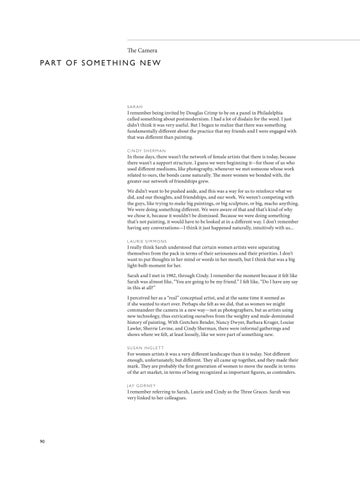The Camera
PA RT O F S O M E T H I N G N E W
SAR AH
I remember being invited by Douglas Crimp to be on a panel in Philadelphia called something about postmodernism. I had a lot of disdain for the word. I just didn’t think it was very useful. But I began to realize that there was something fundamentally different about the practice that my friends and I were engaged with that was different than painting. C I N DY S H E R M A N
In those days, there wasn’t the network of female artists that there is today, because there wasn’t a support structure. I guess we were beginning it—for those of us who used different mediums, like photography, whenever we met someone whose work related to ours, the bonds came naturally. The more women we bonded with, the greater our network of friendships grew. We didn’t want to be pushed aside, and this was a way for us to reinforce what we did, and our thoughts, and friendships, and our work. We weren’t competing with the guys, like trying to make big paintings, or big sculpture, or big, macho anything. We were doing something different. We were aware of that and that’s kind of why we chose it, because it wouldn’t be dismissed. Because we were doing something that’s not painting, it would have to be looked at in a different way. I don’t remember having any conversations—I think it just happened naturally, intuitively with us... L AURIE SIMMONS
I really think Sarah understood that certain women artists were separating themselves from the pack in terms of their seriousness and their priorities. I don’t want to put thoughts in her mind or words in her mouth, but I think that was a big light-bulb moment for her. Sarah and I met in 1982, through Cindy. I remember the moment because it felt like Sarah was almost like, “You are going to be my friend.” I felt like, “Do I have any say in this at all?” I perceived her as a “real” conceptual artist, and at the same time it seemed as if she wanted to start over. Perhaps she felt as we did, that as women we might commandeer the camera in a new way—not as photographers, but as artists using new technology, thus extricating ourselves from the weighty and male-dominated history of painting. With Gretchen Bender, Nancy Dwyer, Barbara Kruger, Louise Lawler, Sherrie Levine, and Cindy Sherman, there were informal gatherings and shows where we felt, at least loosely, like we were part of something new. SUSAN INGLETT
For women artists it was a very different landscape than it is today. Not different enough, unfortunately, but different. They all came up together, and they made their mark. They are probably the first generation of women to move the needle in terms of the art market, in terms of being recognized as important figures, as contenders. J AY G O R N E Y
I remember referring to Sarah, Laurie and Cindy as the Three Graces. Sarah was very linked to her colleagues.
90


























